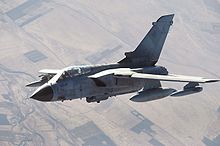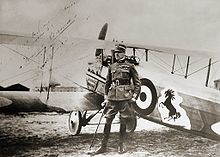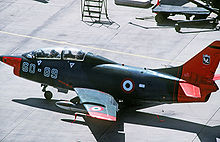Aeronautica Militare
|
Italian Air Force |
|
|---|---|
 Aeronautica Militare coat of arms |
|
| Lineup | 1923 as Regia Aeronautica |
| Country |
|
| Armed forces | Italian armed forces |
| Type | Armed forces |
| structure | Air Fleet Command Logistics Command Training Command |
| Strength | 42,000 soldiers (actual strength 2013) |
| Headquarters of the General Staff |
Palazzo Aeronautica , Rome Italy |
| Nickname | Arma Azzurra |
| Patron saint | Black Madonna Loreto |
| motto | Virtute Siderum Tenus |
| management | |
| Chief of the Air Force General Staff |
General Alberto Rosso |
| insignia | |
| Aircraft cockade |

|
The Italian Air Force , Italian Aeronautica Militare (Italiana) , together with the Army , Navy and Carabinieri form the armed forces of Italy . It reports to the General Staff of the Air Force ( Stato Maggiore Aeronautica - SMA) in the Ministry of Defense in Rome . By 2012, the target strength was 44,000 soldiers, by 2024 the new staffing level of 33,800 men and women is to be gradually achieved.
organization
The General Staff of the Air Force, subordinate to the General Staff of the Armed Forces, is primarily responsible for planning and policy matters. Subordinate to it are three large command areas:
- Air Fleet Command ( Comando della Squadra Aerea - CSA) (Rome)
- Logistic Command ( Comando Logistico - COMLOG) (Rome)
- Training Command ( Comando Scuole dell'Aeronautica Militare - CSAM) ( Bari )
Air Fleet Command
The Comando della Squadra Aerea leads through four sub-commands almost all operational units and thus around half of the military personnel in the Italian Air Force. As force providers, three sub-commands are responsible for the command of the troops and the operational readiness of the subordinate units. The combat units are subordinate to the Comando delle Forze da Combattimento in Milan , the air transport units and the object protection , rescue and special forces bundled in the 1ª Brigata Aerea are subordinate to the Comando delle Forze di Supporto e Speciali in Rome-Centocelle , and other smaller, specialized support units of the 9ª Brigata Aerea ISTAR - EW in Pratica di Mare near Rome.
The operational command Comando delle Operazioni Aeree (COA) in Poggio Renatico near Ferrara is responsible for air surveillance and the operational management of assigned air forces . This goes from the rescue helicopters use up to scrambles of interceptors ( "Scramble"). Two operational command groups in Poggio Renatico and Licola with a total of 13 additional radar units (received RAT 31DL ) are permanently under the control of the COA . There is also a mobile operations center in Bari , which is also available for missions abroad. The COA maintains coordination offices at the four Area Control Centers of the Italian civil air traffic control .
The central operational unit of the Italian Air Force is the squadron (it. "Stormo", dt. (Bird) swarm ), which is comparable to a regiment in the army. Larger flying formations are called "air brigades", of which there are only a few. In addition to staff units and the operations center, the squadron commodore , a colonel, reports to the following "groups" (cf. battalion ):
- 1–2 (possibly 3) flying groups, resp. depending on the type of aircraft or type of use
- "Technical support group" (technical support, weather service, air traffic control)
- "Logistic support group" (infrastructure, fire brigade, healthcare)
- "Aircraft maintenance group" (shipyard; not at all locations, only for one type at a time)
- "Defense group" (object protection and air defense)
- 1 squadron with liaison aircraft and, if necessary, rescue helicopters.
Some terminological peculiarities are important here. As in Italy, the flying group of a German squadron is divided into squadrons ("Squadriglie"). The German Air Force now has one flying group per squadron, usually with two flying squadrons of around 20 aircraft each, which are usually commanded by a major. Because one does not want to group twelve to 18 aircraft in one unit (squadron) with the rank of a company in Italy , there 12-18 aircraft represent a flying group, ie an association at battalion level, which is normally led by a lieutenant colonel. The further subdivision into "Squadriglie" (squadrons) is only of an administrative nature and is mainly for reasons of tradition. Nevertheless, “Gruppo” is usually translated as “Staffel” or English “Squadron”.
Below is a list of the most important Italian military airfields with the units and airborne units stationed there, the types of aircraft used and comments on their tasks.
| Military airfield | squadron | Seasons | Type | Remarks |
|---|---|---|---|---|
| Amendola | 32º Stormo | 13, 28, 61 | F-35A , Reaper , Predator | Fighter-bombers (also on Luke AFB ), drones (also Sigonella ) |
| Aviano | 31st Fighter Wing | 510, 555 | F-16C / D | Association of the United States Air Forces in Europe |
| Cameri | - | - | Typhoon , Tornado , F-35 | Maintenance center |
| Cervia | 15º Stormo | 23, 81, 83 | AW101 , AW139 , AB 212 | Rescue helicopter , parts in Pratica, Gioia, Trapani, Decimomannu |
| Decimomannu | - | 80 | various; FROM 212 | Air Weapons Training Installation; SAR |
| Frosinone | 72º Stormo | 208 | NH-500E | Helicopter flight school; NH-500E also in other locations |
| Furbara | 17º Stormo | - | - | Special unit (airmobile ground forces) |
| Ghedi | 6º Stormo | 102, 154, 155 | Tornado IDS / ECR | Fighter-bomber, reconnaissance aircraft, SEAD |
| Gioia del Colle | 36º Stormo | 10, 12; 84 | Typhoon, AW139 | Hunter, SAR |
| Grazzanise | 9º Stormo | 21st | FROM 212ICO | CSAR , support special forces |
| Grosseto | 4º Stormo | 9, 20 | Typhoon | Hunter |
| Istrana | 51º Stormo | 132 | Typhoon, AMX | Hunters, fighter-bombers, scouts |
| Latina | 70º Stormo | 207 | SF-260EA , P2006T | Flight school |
| Lecce | 61º Stormo | 212, 213 (214) | MB-339 , M-346 | Flying school, light fighter-bombers |
| Martina Franca | 16º Stormo | - | - | Object protection association (ground troops) |
| Pisa | 46ª Brigata Aerea | 2, 50, 98 | C-130J , C-27J | Air transportation, air refueling |
| Pratica di Mare | 14º Stormo | 8, 71; 85; 311 | KC-767 , P. 180 ; various | Tanker, transport, EloKa , CSAR, flight test center |
| Rivolto | 2nd Stormo | 58, 72, 80; 313 | Spada , MB-339 | Anti-aircraft missiles , Frecce Tricolori aerobatic team |
| Rome Ciampino | 31º Stormo | 93, 306 | A-319CJ , Falcon 900 , AW139 | Readiness to fly |
| Salto di Quirra | - | - | various | Missile launch site, defense engineering offices |
| Sigonella | 41º Stormo | 88; 61 | ATR 72 MP; Predator | Maritime patrol aircraft , 61 to 32º Stormo (Amendola); US base |
| Trapani | 37º Stormo | 18; 82 | Typhoon, AW139 | Hunter, SAR; NAEW & C base ( E-3A ) |
| Verona-Villafranca | 3º Stormo | - | - | Mission support (airmobile) |
The 96 Typhoon , which went into service in 2004 , were initially used exclusively as fighter aircraft, first from Grosseto and Gioia del Colle, later also in Trapani and finally stationed in Istrana. Of the 100 tornadoes taken over from 1982 onwards , around 50 repeatedly modernized combat aircraft are still active in Ghedi (and at the flight test center in Pratica di Mare), 16 of them in the ECR version. These machines were first put into service in Ghedi, later they flew at various times with squadrons in Gioia del Colle, Istrana and Piacenza. From 1989 onwards, 136 light fighter-bombers of the type AMX were added to the tornados , of which only a few, comprehensively modernized specimens are in service in Istrana and are also being replaced by Typhoon there. In 2016, Amendola’s 32nd Squadron took over the first Cameri-built Lockheed Martin F-35 . A total of 75 of these machines (15 more will go to the Navy ) are to replace the AMX that have already been decommissioned in Amendola and the remaining tornadoes in Ghedi . This means that around 170 Typhoon and F-35 fighter aircraft will be available to the Italian Air Force in the future .
Aeronautica Militare has 18 twin-engine lead-in fighter trainers of the Alenia Aermacchi M-346 type to replace the formerly more than 130 jet trainers and light ground attack aircraft of the Aermacchi MB 339 type , of which around half are still in Lecce and several other locations ordered and 45 single jet jet trainers of the type M-345 , some of which are also firmly ordered. The new standard helicopters are the AgustaWestland AW101 and the AW139 . Four new KC-767A tankers were purchased to replace four old Boeing 707T / T aircraft . With the Gulfstream G550 CAEW , the Italian Air Force was able to set in motion the long-sought development of a small, national AWACS component. In the area of air defense, there are currently only object protection capacities ( Spada ). The SAMP / T air defense systems are part of the army in Italy .
Logistics command
The Comando Logistico (COMLOG) is responsible for the entire technical, logistical and administrative operations in the Italian Air Force, unless it is carried out by the task forces themselves. COMLOG is divided into three divisions:
- 1. COMLOG division : flight test center, flight medicine, scientific services, etc. a.
- 2. COMLOG division: technical documentation, material maintenance aircraft, shipyards, depots
- 3. COMLOG division: Technical documentation, material maintenance C-4 systems
In addition, the logistics command is responsible for the medical, administrative and infrastructure services as well as defense testing and training centers in Salto di Quirra in Sardinia .
For territorial tasks there are still two territorial air force regions in Milan (1st) and Bari (3rd) as well as a department for tasks in Rome.
Training command
The Comando delle Scuole in Bari (until 2007 in Guidonia Montecelio near Rome ) is responsible for the recruitment, training and further training of all personnel in the Italian Air Force. The Air Force's central personnel selection center is located in Guidonia Montecelio . Teams are trained in the training center in Taranto . The non-commissioned officers' school in Caserta is responsible for technical staff and prospective NCOs without portepee , which is housed there in the area of the royal palace . For the candidates for the higher non-commissioned officer career, who predominantly come directly from civil high schools, the non-commissioned officers' school in Viterbo, in cooperation with the University of Tuscia, takes on the training, as part of which a three-year bachelor's degree in economics and organizational sciences has to be completed. Prospective officers are u. a. trained at the Air Force Academy in Pozzuoli and can later attend advanced training courses or general staff courses at the Air Force Command Academy ( Istituto di Scienze Militari Aeronautiche ) in Florence and at the Armed Forces Command Academy ( CASD ) in Rome. For flight training, the Comando delle Scuole is also responsible for the training squadrons (listed in the above list) in Latina , Frosinone and Lecce as well as training centers in the USA and Canada (including Sheppard , Moose Jaw ). At the pilgrimage site of Loreto there is a training and foreign language center ( Black Madonna of Loreto is the patron saint of Aeronautica Militare ), in Rome there is a medical school and in Guidonia Montecelio there is a gliding school and the so-called Scuola di Aerocooperazione , the members of all armed forces and other authorities, especially in the Training in aerial and satellite image analysis (IMINT). The military aviation museum in Vigna di Valle on Lake Bracciano , which is worth seeing, is also under the command in Bari . The Aeronautica Militare sports center with a sports promotion group is also located there .
In Florence the training command maintains the military high school "Giulio Douhet". There, young people can complete an aerospace technology -oriented upper level and take the Abitur . The school is militarily oriented and the students have the status of soldiers . After finishing school, they can return to civilian life or pursue a military career.
history
Military aviation began in Italy in 1884 with the establishment of an airship unit with the 3rd Army Pioneer Regiment in Rome. Italy was the first country in the world to use planes in a war. On October 22nd, 1912, during the Italo-Turkish War, Captain Piazza in Libya flew the first “bombing mission” in military aviation history with a Blériot XI .
During the First World War , the cavalry officer Francesco Baracca stood out. Had a major impact on the air forces of all States Air Force strategist General Giulio Douhet , who first described the strategic effects of carpet bombing, which by the Italian Air Force ( Corpo Aeronautico Militare ) with their large Caproni - bombers Ca.3 , about 4 and Ca. 5 were flown for the first time and were later implemented on a large scale by the Allies during World War II .
The Italian Air Force itself was founded as an independent armed force on March 28, 1923 under the name Regia Aeronautica (Eng. "Royal Air Force"). Essentially, it was about the merger of the army and navy air forces, which were then banned from having their own flying units. In the period between the two world wars, the Air Force made a name for itself thanks to the support of the fascist regime Benito Mussolini and the aviation pioneers around Arturo Ferrarin , Francesco De Pinedo , Umberto Nobile and Italo Balbo and set numerous international records.
In the Spanish Civil War from 1936 to 1939, the Regia Aeronautica was still one of the more technically advanced. When the war began in 1940, however, the technology lagged behind that of other countries. Only later the Italians were the manufacture under license of the German Daimler-Benz - aircraft engines more modern and powerful fighter planes such as the Macchi MC.202 build. Italian bombers flew long-range missions a. a. to the Persian Gulf . Especially the torpedo pilots (" Aerosiluranti ") were able to cause severe damage to the British fleet despite difficult circumstances.
With the Allied invasion of Italy and the Armistice of Cassibile in September 1943, the Italian Air Force also split up until the end of World War II. In the south of the country the Aeronautica Cobelligerante Italiana cooperated with the Allies, in the north the Aviazione Nazionale Repubblicana of the fascist Italian Social Republic remained allied with Germany.
After the war, with the abolition of the monarchy in 1946, the air force was renamed “Aeronautica Militare”. From 1951, when the arms restrictions were lifted, the air force was re-armed within the framework of NATO and, thanks to American military aid, was able to achieve a fairly high level of deployment in the 1950s. The squadrons of the Italian Air Force were temporarily restructured into air brigades ("aerobrigate"). During these years, Italian companies such as Aeritalia , Agusta and Aermacchi began again to equip the air force with modern aircraft. a. with the Fiat G.91 , the Aermacchi MB 326 and the Aeritalia G.222 . In addition, they produced under license and participated in first international projects such as the Panavia Tornado . Up until the 1990s, the “Aeronautica Militare” had a more territorial structure with two air force regions (1st in Milan and 3rd in Bari) and associated Regional Operations Centers (ROC). In 1999, the Italian Air Force finally got a modern, more function-oriented structure.
Tanker Boeing 707 -TT
Also used by the Pope SH-3D / TS
coat of arms
The coat of arms of the Italian Air Force shows a crowned eagle and a banner with the inscription Virtute Siderum Tenus ( something like : "With bravery to the stars") the emblems of the four most successful squadrons in World War I.
See also
Web links
- The Italian Air Force on the Internet (Italian / English)
- Photos of aircraft of the Italian Air Force
Individual evidence
- ↑ http://www.aeronautica.difesa.it/storia/Pagine/Araldica.aspx Description of the coat of arms













